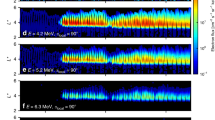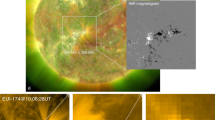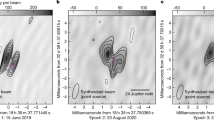Abstract
The Earth's radiation belts—also known as the Van Allen belts1—contain high-energy electrons trapped on magnetic field lines2,3. The centre of the outer belt is usually 20,000–25,000 km from Earth. The region between the belts is normally devoid of particles2,3,4, and is accordingly favoured as a location for spacecraft operation because of the benign environment5. Here we report that the outer Van Allen belt was compressed dramatically by a solar storm known as the ‘Hallowe'en storm’ of 2003. From 1 to 10 November, the outer belt had its centre only ∼10,000 km from Earth's equatorial surface, and the plasmasphere was similarly displaced inwards. The region between the belts became the location of high particle radiation intensity. This remarkable deformation of the entire magnetosphere implies surprisingly powerful acceleration and loss processes deep within the magnetosphere.
This is a preview of subscription content, access via your institution
Access options
Subscribe to this journal
Receive 51 print issues and online access
$199.00 per year
only $3.90 per issue
Buy this article
- Purchase on Springer Link
- Instant access to full article PDF
Prices may be subject to local taxes which are calculated during checkout



Similar content being viewed by others
References
Van Allen, J. A. in Discovery of the Magnetosphere (eds Gillmor, C. S. & Spreiter, J. R.) 235–251 (Vol. 7, History of Geophysics, American Geophysical Union, Washington DC, 1997)
Vette, J. I. The AE-8 Trapped Electron Model Environment (NSSDC WDC-A-R&S 91-24, NASA Goddard Space Flight Center, Greenbelt, Maryland, 1991)
Brautigam, D. H., Gussenhoven, M. S. & Mullen, E. G. Quasi-static model of outer zone electrons. IEEE Trans. Nucl. Sci. 39, 1797–1803 (1992)
Lyons, L. R. & Thorne, R. M. Equilibrium structure of radiation belt electrons. J. Geophys. Res. 78(13), 2142–2149 (1973)
Baker, D. N. How to cope with space weather. Science 297, 1486–1487 (2002)
Lopez, R. E., Baker, D. N. & Allen, J. H. Sun unleashes Halloween storm. Eos 85, 105, 108 (2004)
Baker, D. N. et al. An overview of the Solar Anomalous, and Magnetospheric Particle Explorer (SAMPEX) mission. IEEE Trans. Geosci. Remote Sens. 31, 531–541 (1993)
Li, X. et al. The predictability of the magnetosphere and space weather. Eos 84, 361, 369–370 (2003)
Baker, D. N., Kanekal, S. G., Pulkkinen, T. I. & Blake, J. B. Equinoctial and solstitial averages of magnetospheric relativistic electrons: A strong semiannual modulation. Geophys. Res. Lett. 26, 3193–3196 (1999)
Blake, J. B. et al. New high temporal and spatial resolution measurements by SAMPEX of the precipitation of relativistic electrons. Adv. Space Res. 18, 171–177 (1996)
Looper, M. D. et al. Observations of remnants of the ultrarelativistic electrons injected by the strong SSC of 24 March 1991. Geophys. Res. Lett. 21, 2079–2082 (1994)
Li, X. et al. Simulation of the prompt energization and transport of radiation particles during the March 23, 1991 SSC. Geophys. Res. Lett. 20, 2423–2426 (1993)
Li, X. in Proc. 6th Int. Conf. on Substorms (ICS6) (ed. Winglee, R. M.) 305–311 (Univ. Washington Press, Seattle, Washington, 2000)
Carpenter, D. L. & Park, C. G. What ionospheric workers should know about the plasmapause/plasmasphere. Rev. Geophys. 11, 133–154 (1973)
Grebowsky, J. M. Model study of plasmapause motion. J. Geophys. Res. 75, 4329–4333 (1970)
Thorne, R. M., Smith, E. J., Burton, R. K. & Holzer, R. E. Plasmaspheric hiss. J. Geophys. Res. 78 (10), 1581–1598 (1973)
Lorentzen, K. R., Blake, J. B., Inan, U. S. & Bortnik, J. Observations of relativistic electron microbursts in association with VLF chorus. J. Geophys. Res. A 106, 6017–6027 (2001)
Burch, J. L. et al. Views of the Earth's magnetosphere with the IMAGE satellite. Science 291, 619–624 (2001)
Sandel, B. R., Goldstein, J., Gallagher, D. L. & Spasojevic, M. Extreme ultraviolet imager observations of the structure and dynamics of the plasmasphere. Space Sci. Rev. 109, 25–46 (2003)
Goldstein, J. et al. Simultaneous remote sensing and in situ observations of plasmaspheric drainage plumes. J. Geophys. Res. 109, doi:10.1029/2003JA010281 (2004)
Russell, C. T., Cartwright, M. & Kanekal, S. The formation of the inner zone trapped radiation belt. Adv. Space Res. (in the press)
Liu, W. W., Rostoker, G. & Baker, D. N. Internal acceleration of relativistic electrons by large-amplitude ULF pulsations. J. Geophys. Res. 104, 17391–17407 (1999)
Summers, D., Thorne, R. M. & Xiao, F. Relativistic theory of wave-particle resonant diffusion with application to electron acceleration in the magnetosphere. J. Geophys. Res. A 103, 20487–20500 (1998)
Summers, D. & Thorne, R. M. Relativistic electron pitch-angle scattering by electromagnetic ion cyclotron waves during geomagnetic storms. J. Geophys. Res. 108, doi:10.1029/2002JA009489 (2003)
Webb, D. F. & Allen, J. H. Spacecraft and ground anomalies related to the October-November 2003 solar activity. Space Weather 2, doi:10.1029/2004SW000075 (2004)
Acknowledgements
This work was supported by NASA. We thank members of the SAMPEX and IMAGE science teams for data and discussions.
Author information
Authors and Affiliations
Corresponding author
Ethics declarations
Competing interests
The authors declare that they have no competing financial interests.
Rights and permissions
About this article
Cite this article
Baker, D., Kanekal, S., Li, X. et al. An extreme distortion of the Van Allen belt arising from the ‘Hallowe'en’ solar storm in 2003. Nature 432, 878–881 (2004). https://doi.org/10.1038/nature03116
Received:
Accepted:
Issue Date:
DOI: https://doi.org/10.1038/nature03116
This article is cited by
-
The Possible Cause of Most Intense Geomagnetic Superstorm of the 21st Century on 20 November 2003
Solar Physics (2023)
-
Combined model of topside ionosphere and plasmasphere derived from radio-occultation and Van Allen Probes data
Scientific Reports (2022)
-
Artificial modification of Earth’s radiation belts by ground-based very-low-frequency (VLF) transmitters
Science China Earth Sciences (2022)
-
The Relativistic Electron-Proton Telescope (REPT) Investigation: Design, Operational Properties, and Science Highlights
Space Science Reviews (2021)
-
Vacuum-ultraviolet photodetectors
PhotoniX (2020)
Comments
By submitting a comment you agree to abide by our Terms and Community Guidelines. If you find something abusive or that does not comply with our terms or guidelines please flag it as inappropriate.



